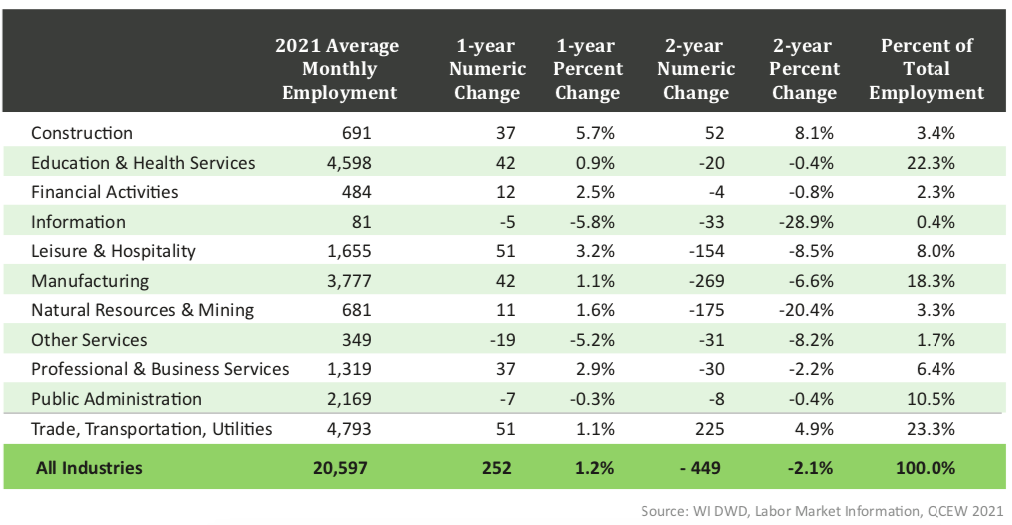Monroe County
Monroe County is Wisconsin’s 31st most populated county with an estimate of 46,697 residents in 2022. The county registered population growth in five consecutive decades. It gained 423 residents in the first two years of the 2020s, or 0.9% of its population. By comparison, Wisconsin’s population grew 0.9% and population in the United States rose 0.3% over the same period. Nine of the county’s 10 most populous municipalities added residents. The Town of Angelo gained the most residents (107), while the Town of Byron lost one resident.
Employment Change By Industry

In Monroe County, the manufacturing industry experienced the greatest numerical loss in employment in 2020 because of the pandemic. The industry rebounded in 2021, gaining 42 (1.1%) jobs over the year. For comparison, the manufacturing industry in the state grew roughly 1.6% during the same time frame. On the other hand, the strong growth number in trade, transportation, utilities was encouraging. The industry added 51 jobs during the year 2021, the highest in the county, surpassing the 2019 employment level by 4.9%. Leisure and hospitality industry also added 51 jobs over the year. However, the employment level is still down 8.5% from 2019.
In April of 2020, Monroe County’s unemployment rate climbed 8.7%, resulting in a peak rate of 12.1%, significantly higher than the rates following the 2008 financial crisis. In November 2021, nearly two years after this initial spike, the unemployment rate fell to a historic low of 2%. However, high inflation has slowed the rapid economic recovery. In June 2022, the Consumer Price Index for All Urban Consumers increased 9.1% year-over-year, the largest increase in 40 years. The economy began to slow down as the Federal Reserve raised interest rates to tackle inflation. Despite this challenge, industries remained resilient. The unemployment rate remained low at 2.2% in December 2022.
Transportation
Monroe County is a rural county. About one-fifth of the residents travel outside of the county for work, and 19.5% of those that work in the county reside in another county. The Scenic Mississippi Regional Transit System provides weekday bus services in the county connecting Tomah and Sparta to the city of La Crosse. However, 86.4% of employed county residents rely on a car to get to work and over three quarters drive alone. The average commute time is 19.5 minutes. Car-centered infrastructure leads to a difficult conundrum: qualified individuals could fill a job if they had transportation and could afford transportation if they had a job. Some employers address this issue by offering telecommuting and transportation reimbursements.
Housing
Affordable and available housing that can fit different lifestyles and family needs are essential to attracting and retaining a productive workforce. Less time commuting lead to higher productivity and better mental health. However, as of December 2022, home prices have surged almost 40% since 2020, while mortgage rates have more than doubled since the beginning of the year. This has priced many buyers out of the market and slowed the construction of new homes, putting more stress on the rental market. High housing costs discourage job seekers from moving into the region, leading to a worker shortage, especially for lower-wage roles.
According to the National Low Income Housing Coalition, the state has a shortage of more than 120,000 rental units. Owner-occupied housing is in short supply in many communities as well. Like the state, construction of new homes in the county slowed down significantly after the housing bubble burst in 2008. A direct way to increase the number of quality and affordable housing stock is incentivizing the creation of new multi-family units, which requires loosening zoning regulation. Stabilizing existing neighborhoods is also important. This includes provides more funds and loans for replacement housing, and housing rehabilitation.
Child Care
In Monroe County, the average childcare cost is approximately the same as the state. The monthly cost of care ranges from $742 for an infant to $583 for a school-age child. To put this cost in perspective, a household with median earnings in Monroe County would need to pay 14% of their earnings on infant care. Childcare availability is also a barrier to employment for Wisconsin families. There is no definitive source for access or availability relative to need. According to the YoungStar provider database, which tracks approximately 82% of providers in the state, there are 24 total providers with a potential capacity of 549 in Monroe County. The county has a relatively low capacity when compared to the state. There are six childcare slots for every 100 children under the age of 14 in Monroe County compared to 14 statewide. Additionally, even families that have childcare struggle with care disruptions. Easing challenges of cost and access would help more parents attain their full employment potential. Employers could also help improve participation by providing flexibility to parents with childcare responsibilities.
